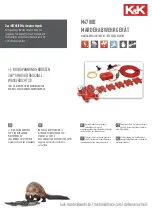
CY8CKIT-149 PSoC® 4100S Plus Prototyping Kit Guide, Doc. #: 002-20729 Rev. *E
36
A.2.3
Power Supply System
The power supply system on this board is dependent on a power source for most applications, you
can use the 5 V supply from the USB connection to power the system. You can also connect an
external power supply to the board for low-voltage applications. The kit supports the following
connections:
■
5 V from the KitProg2 USB (
J8
)
■
1.8 V to 5.0 V from a regulated supply connected to VTARG or VDDD
Note:
To use an external power supply with the KitProg2 also connected to the PC USB, first remove
diode D1 from the board. This ensures that the VTARG supply from KitProg2 is not supplied to the
target device. KitProg2 measures the target voltage and adjusts the logic levels on the programming
pins accordingly.
A.2.3.1
Measure PSoC 4100S Plus Device Current Consumption
Follow these steps to measure the current consumption of the PSoC 4100S Plus device:
1. Remove the resistor R53 and install a 2-pin jumper in the supplied holes of
J3
.
2. Connect an ammeter across the 2-pin jumper to measure the current to the PSoC 4100S Plus
device.
This method can be used either with USB power or with the power supplied to one of the VTARG
pins but NOT when supplying power to one of the VDDD pins.
After measuring the current consumption, populate resistor R53 or place a shorting jumper across
the two jumper pins for normal operation of the kit.
Note:
After removing R53, system may have some leakage power. Below are some of the probable
paths for leakage:
1. Communication circuitry between KitProg2 and Target (I2C, UART, SWDIO)
2. Inductive Beads for BLE power circuitry
3. Reset switch between KitProg2 and target device along with BLE device
To get rid of the leakage power completely, remove the 0 ohm connection and inductive beats.
Caution:
It is important to understand that this prototyping kit does not
have any onboard ESD protection circuitry. Therefore, the power source
for the PSoC 4100S Plus Prototyping Kit must be of high quality to make
sure that the board is protected from any over-current conditions and
swapped-power connections.
















































